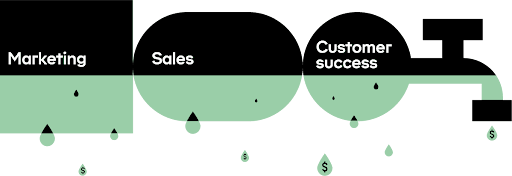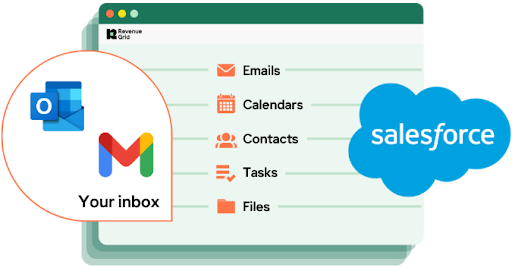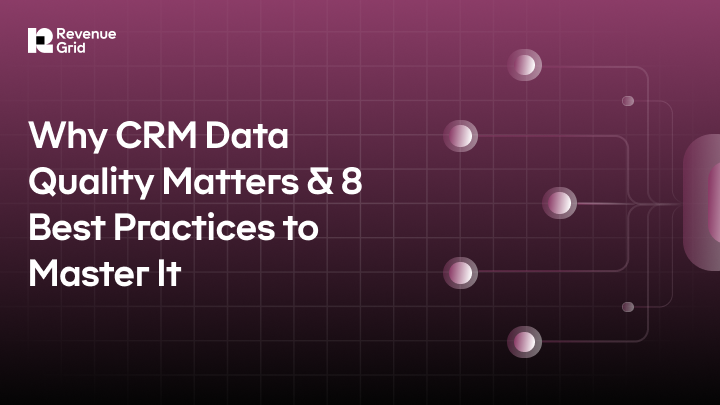Key Takeaway
- Your CRM is only as strong as the data powering it. Automate activity capture to keep every email, meeting, and call synced to Salesforce, so your CRM always reflects reality, not manual updates.
- Get complete visibility into every client relationship. Detect gaps, track engagement, and ensure no deal slips through due to missing or outdated data.
- Revenue Grid turns CRM data into actionable intelligence. With automated capture, real-time validation, and AI-powered insights, your teams can focus on selling while improving forecast accuracy and compliance.
A sales rep follows up on a deal that closed weeks ago. A forecast misses the mark because duplicates inflated the pipeline. Managers plan strategy on outdated data, unaware the truth has already shifted.
This is what bad CRM data looks like. It is silent, slow, and costly. It erodes trust in forecasts, weakens relationships, and wastes hours of selling time. Deloitte estimates companies lose up to $14 million a year to poor data quality, and the impact goes beyond revenue leakage. It distorts visibility, clouds judgment, and hides risk where precision should live.
CRM data quality is more about reliability than perfection. One needs to know that what you see in Salesforce reflects what’s actually happening with customers right now. In this article, we’ll look at what clean CRM data really means, why it breaks down, and eight proven ways to fix it before it quietly breaks your business.
What Does “Clean” Data Quality for CRM Really Mean?
Clean CRM data isn’t about having a tidy database. It’s about knowing that every contact, deal, and activity logged in Salesforce reflects the truth of what’s happening in the field.
Good data checks five simple boxes:
- Accuracy: Is it correct?
- Completeness: Is anything missing?
- Timeliness: Is it current?
- Consistency: Does it match across systems?
- Relevance: Does it serve your sales goals?
When even one of these slips, the domino effect starts. Reps chase the wrong leads. Managers miss early warning signs. Marketing spends on audiences that no longer exist. IT scrambles to clean up systems that never align. It’s a risk that quietly compounds over time.
Inaccurate records and missing consent data cost Italian telecom company TIM S.p.A. €7.6 million in GDPR fines in 2023, a clear reminder that poor CRM hygiene can turn into a compliance risk overnight.
Also Read: 7 Causes of a Leaky Sales Pipeline
And the truth is, no company is immune. Even the best-intentioned teams end up here because CRM data rarely breaks in one place, it decays everywhere, bit by bit. That brings us to the real question, why does this happen?
Causes for Poor Quality CRM Data
Most teams don’t set out to create bad data. It creeps in quietly, starting with one missed field, one duplicated contact, one unlogged meeting at a time. Over months, it snowballs into a system that looks full but tells half the story.
Siloed Data Across Systems
When marketing, sales, and customer success tools don’t talk to each other, each builds its own version of the truth. Reps lose visibility, campaigns misfire, and managers end up reconciling spreadsheets instead of planning strategy. McKinsey estimates that data silos cost businesses $3.1 trillion every year in lost productivity and missed opportunities.
Pro tip: Integrate every customer touchpoint into one connected CRM view. Real-time sync isn’t just a convenience, this is how you keep truth consistent across teams.
Duplicate or Overlapping Records
Different people, different inputs, same contact. “Jon Smith” in one entry, “Johnathan Smith” in another. These overlaps inflate pipelines, split ownership, and blur accountability. KPMG found that 94% of businesses believe their customer data is inaccurate, often because of duplication at entry.
Pro tip: Enforce standardized naming conventions and use automatic deduplication tools to catch errors before they spread.

Siloed data across teams can cause severe revenue leaks.
Incomplete Data
A contact without an email. A deal without a stage. A meeting never logged. Incomplete data breaks visibility and leaves managers guessing. CAPIS, an institutional broker, faced this same challenge until they used Revenue Grid’s Activity Capture to automatically sync emails, meetings, and calls between Outlook and Salesforce. The outcome: full visibility, cleaner records, and more time for selling, not updating CRMs.
Case Study:
CAPIS, a leading institutional broker, struggled with incomplete CRM records, inconsistent data, and time-consuming manual updates. After implementing Revenue Grid’s Activity Capture and Sidebar, they automated data syncing between Outlook and Salesforce, ensuring every email, meeting, and interaction was logged automatically. The result: improved visibility for managers, stronger client follow-ups, and hours saved weekly that reps could redirect toward selling instead of updating records.
Irrelevant or Stale Data
Contacts go cold. Companies rebrand. People move on to new roles. HubSpot reports that nearly a quarter of business contacts become obsolete every year. When outdated records stay in circulation, budgets drain and deals die quietly. Automated enrichment, like the kind Revenue Grid provides, keeps data fresh and relevant so your CRM reflects reality, not last year’s version of it.
Lack of Ownership and Maintenance
When everyone owns CRM hygiene, no one really does. Without accountability, updates slip, and trust in the system fades. Over time, decisions are made on partial data, forecasts lose credibility, and compliance risk rises.
Bad data both distorts insight and wastes efforts. That’s why high-quality CRM data is about clarity. When every record reflects the real relationship, strategy becomes sharper and decisions stronger.
Next, we’ll look at what good CRM data quality looks like when it’s done right and why that difference matters.
Revenue Grid, for instance, takes the guesswork and human error out of CRM data management by automatically capturing real sales activities from emails, calendars, and calls. Its automated data capture, deduplication, and enrichment features remove distortions that skew sales forecasts and waste time.
What Does High Data Quality for CRM Look Like?
When CRM data is right, you don’t need to question it. Every record is current, connected, and credible. You can open Salesforce on a Monday morning and trust that what you see is exactly what’s happening in the field.
High-quality CRM data has three defining traits:
- It’s current. Every update from emails, meetings, and calls appears in real time, not after someone remembers to log it.
- It’s connected. Sales, marketing, and success teams work from one shared truth instead of scattered versions.
- It’s contextual. Each data point has meaning, not just a field filled, but a full story of engagement behind it.
When data flows like this, forecasting becomes less guesswork and more confidence. Reps know which opportunities are active, managers see where deals are stalling, and leaders act with precision instead of patching together fragments.
This is what platforms like Revenue Grid make possible: a living CRM that evolves with every interaction. With automatic syncing, enrichment, and validation, your system doesn’t just store data; it learns from it. It aligns teams, sharpens strategy, and turns information into action.
Before teams reach this point of clarity, most have to deal with the slow drag of data decay and the chaos it leaves behind. That’s why understanding why high-quality data matters isn’t optional. It’s what separates companies that scale confidently from those constantly playing catch-up.
Why Is High Quality CRM So Important For Business?
When CRM data is accurate, every part of the revenue engine runs smoother. Forecasts tighten, deals move faster, and decisions come from facts. It’s the difference between leading with confidence and reacting to what’s already gone wrong.
Accurate Forecasting & Pipeline Visibility
With real-time, trustworthy data, leaders can forecast confidently and spot risks early. Clean data exposes patterns that messy spreadsheets hide. A 2022 McKinsey study found that AI-driven forecasting built on high-quality data can reduce errors by up to 50%. That’s not just better reporting, it’s better resource planning, hiring, and investment timing.
Higher Sales Productivity & Lead Conversions
A Forrester report found that employees can lose up to 12 hours each week searching through fragmented systems. When your CRM is automatically updated, that time goes back to selling. Tools like Revenue Grid automate data capture from every email, meeting, and call, giving reps a complete picture without extra clicks. The result: more qualified leads, shorter sales cycles, and stronger close rates.
Reduced Operational Costs
Poor CRM data doesn’t just slow teams down, it also drains budgets. High-quality CRM data reduces that waste by cutting manual entry, eliminating duplicates, and automating data validation. It keeps operations lean, freeing both time and resources for strategy instead of clean-up.
Compliance & Risk Reduction
In regulated industries, accuracy isn’t optional—it’s a safeguard. Under the General Data Protection Regulation (GDPR), companies can face fines up to €20 million or 4% of global turnover for major violations. Clean CRM data means clean consent records, traceable updates, and clear audit trails—all of which reduce exposure to legal risk.
Better Customer Experience
When every interaction is logged, follow-ups are timely, and outreach feels personal. Clients aren’t forgotten in the shuffle because every touchpoint is visible. A global commercial bank saw this firsthand after deploying Revenue Grid. By streamlining calendar scheduling and automating data syncing, they achieved 50% more new meetings per quarter and saved 15+ hours per banker each week, time reinvested into deepening high-value client relationships.
High-quality data turns your CRM from a static record system into a responsive engine. It brings truth to every dashboard, context to every deal, and direction to every decision.
Next, we’ll look at how to achieve that level of precision and eight practical ways to build and maintain CRM data quality that doesn’t just look clean but performs clean.
How to Ace Your CRM Data Quality: 8 Best Practices
High-quality CRM data doesn’t happen by accident. It’s built on discipline, automation, and clear ownership. These eight practices will help you maintain a CRM that tells the truth every day, not just at audit time.
1. Start with a Comprehensive Data Audit
You can’t fix what you don’t see. A detailed audit reveals where your CRM is breaking, for example, duplicate contacts, empty fields, mismatched formats, or outdated records.
- Review records by type (contacts, companies, deals) and flag inconsistencies.
- Identify duplicate entries with built-in or third-party matching tools.
- Spot-check accuracy against verified sources.
- Trace the origin of bad data: manual entry, imports, or broken integrations.
Once you know where the cracks are, you can stop the data decay before it spreads.
2. Automate Data Entry
Manual data entry is where accuracy dies. It’s also one of the biggest time sinks in sales. Reps actually spend most of their time on admin tasks instead of selling.
Revenue Grid’s Activity Capture solves this by automatically logging every email, meeting, and call into Salesforce. It links contacts, flags duplicates, and fills missing details, all in the background.
Case Study: Slalom Consulting
Slalom’s client data was stuck in Outlook, invisible to Salesforce. With Revenue Grid, they uncovered hidden contacts, synced them automatically, and achieved a 3x increase in auto-created contacts and 80% faster scheduling without extra admin effort.
3. Validate Data at Entry
Every new record should pass accuracy checks before it enters your CRM. Think of it as border control for data quality. Revenue Grid’s validation tools verify email formats, match company names, and flag incomplete fields in real time.
That precision adds up. Teams using automated validation through Revenue Grid report:
- 400% more activity logged
- 90% forecast accuracy
30+ hours saved per rep each month
4. Define Clear CRM Data Standards
Data quality starts with consistency. Set clear rules for how information is formatted and updated, then make them visible.
Pro tips:
- Define standard formats for names, job titles, and company fields.
- Use a single date format across systems.
- Categorize industries or regions using fixed lists.
- Reinforce standards in onboarding and refresh sessions.
- Assign a CRM admin to monitor compliance.
When everyone follows the same structure, reports become reliable, not debatable.
5. Establish Ownership and Accountability
When everyone owns data hygiene, no one does. Assign ownership by team, territory, or lifecycle stage. A designated CRM administrator should monitor accuracy, run reports, and track cleanup progress.
Automated activity status tracking in Revenue Grid keeps every rep and manager accountable. It shows real-time engagement, helping teams focus on what’s moving and what’s stalling.
6. Integrate All Data Tools
A fragmented stack is the biggest threat to CRM truth. When tools don’t sync, data drifts. Integrate marketing, sales, and customer success systems to maintain one complete customer view.

Revenue Grid CRM data quality through smart integrations
Case Study: Morgan & Morgan
Before using Revenue Grid, this U.S. law firm relied on manual Outlook updates, leaving Salesforce incomplete. After integration, every email, task, and client note synced automatically. The firm saw a 15–20% increase in cases processed per month and 93% fewer clicks per task, which is a direct result of connected data.
7. Set, Monitor, and Enforce Data Quality Standards
Data quality isn’t “set it and forget it.” Measure it the way you’d measure sales targets. Track metrics like duplicate rate, completeness, and record freshness.
Use automation to flag issues early like missing fields, repeated errors, or incomplete activity logs. Run quarterly audits and visualize trends using dashboards. Revenue Grid’s analytics can detect recurring problem areas and trigger cleanups automatically.
8. Train, Incentivize, and Continuously Improve
Even the best CRM setup fails without user discipline. Train your team not just on how to manage data, but why it matters. Show them the connection between clean data, faster deals, and better forecasts.
Tie data hygiene to performance metrics or rewards. The more reps see data quality as part of their success, the stronger your CRM gets. With Revenue Grid, most of that hygiene happens automatically, freeing teams to focus on selling while the system maintains accuracy.
Leverage Revenue Grid for High CRM Data Quality Services
Even the smartest CRM can backfire when it runs on bad data. A cluttered system hides insights, breaks trust, and slows growth. The fix isn’t another cleanup sprint — it’s a smarter, automated foundation. That’s what Revenue Grid delivers.
- Automated Data Capture: Syncs every email, meeting, and call directly to Salesforce, no manual entry, no forgotten interactions.
- Real-Time Accuracy: Auto-links contacts, flags duplicates, and validates records as they’re created.
- Complete Visibility: Gives leaders a single, reliable source of truth across all customer touchpoints.
- Compliance & Control: Maintains GDPR-safe governance and keeps audit trails ready for inspection.
- Proven Results: 400% more activity logged, 30+ hours saved per rep, and up to 90% forecast accuracy.
With Revenue Grid, data hygiene becomes invisible, it is handled quietly in the background while teams focus on what drives revenue. It’s how sales organizations move from chasing accuracy to trusting it.
Book a demo to see how Revenue Grid can make your CRM data work as hard as your sales team.


